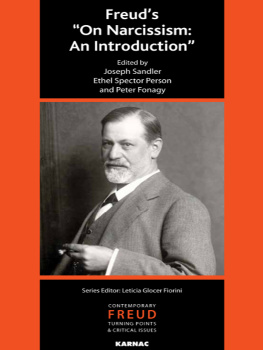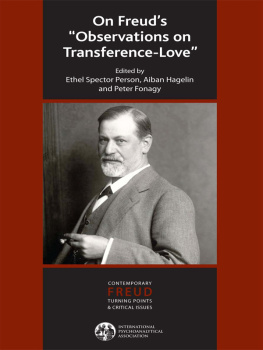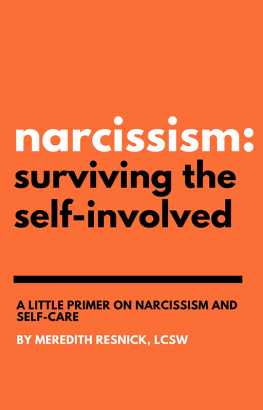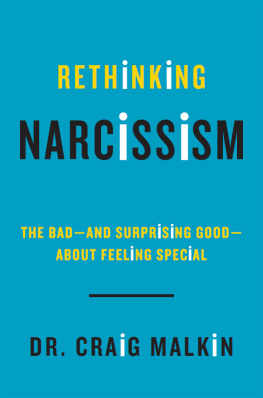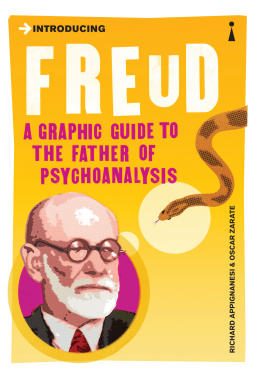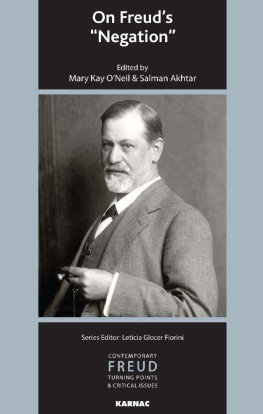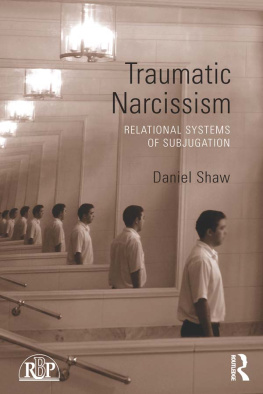Grateful acknowledgement is made to Sigmund Freud Copyrights; The Institute of Psychoanalysis, London; The Hogarth Press; and Basic Books for permission to reprint On Narcissism: An Introduction as published in Sigmund Freud, The Standard Edition of the Complete Works of Sigmund Freud, Vol. 14, trans. and ed. by James Strachey, Hogarth Press, London; and in Sigmund Freud, The Collected Papers of Sigmund Freud, Vol. 4, ed. James Strachey, Basic Books, New York.
First published in 1991 by Yale University Press for the International Psychoanalytical Association, London.
This edition published in 2012 by
Karnac Books Ltd
118 Finchley Road
London NW3 5HT
Copyright 1991, 2012 the International Psychoanalytical Association
All rights reserved. No part of this publication may be reproduced, stored in a retrieval system, or transmitted, in any form or by any means, electronic, mechanical, photocopying, recording, or otherwise, without the prior written permission of the publisher.
British Library Cataloguing in Publication Data
A C.I.P. for this book is available from the British Library
ISBN: 978-1-78049-108-0
Printed in Great Britain
www.karnacbooks.com
Table of Contents
Preface

This is the second volume of the series Contemporary Freud: Turning Points and Critical Issues, the first being On Freuds Analysis Terminable and Interminable. The series was proposed by Robert Wallerstein, who appointed an IPA Committee on Publications under the chairmanship of Joseph Sandler; the proposal grew out of the desire to provide the IPAs membership with a new modality of intellectual interchange. Such an exchange seems more urgent now than ever before because of the increasingly rapid growth of psychoanalysis in different parts of the world, each with a unique and important perspective.
Each publication in this series will begin with one of Freuds classic papers and will be followed by essays by a number of distinguished psychoanalytic teachers from theoretically diverse and geographically dispersed backgrounds. Rather than merely reviewing the pertinent literature, each contributor has been asked to elucidate the essays important points, to clarify what may be ambiguous in the essay, and to establish links between the original paper and important aspects of our present state of knowledge. The contributions are meant to be didactic and to express the contributors views exactly as if he or she were conducting a seminar. Although each volume may be useful as a teaching text, it will also be of immeasurable value to anyone reading or re-reading Freud or exploring a given topicin this case narcissism. It is the hope of the IPA Committee on Publications that each volume will draw the reader into an internal dialogue with the contributors, thus serving as a kind of personal study group.
Given the importance of narcissism to current theoretical concerns, the choice of focusing this volume on Freuds classic essay On Narcissism: An Introduction seems a happy one. Credit goes to Joseph Sandler, who served as chairperson of the Committee on Publications at the time the choice was made and who, with input from his advisory board, selected the contributors for this volume. They, in turn, have been generous in their participation in this project, and the excellent results thereof are self-evident.
Special thanks go to Lynne Mcllroy of the IPA office for her prodigious help in securing permissions and coordinating such an international venture and to Doris Parker of the Columbia Psychoanalytic Center for checking the English references. I also want to thank Gladys Topkis, Eliza Childs, and Cecile Rhinehart Watters for their indispensable editorial input and their patience and care in bringing this volume into existence.
ETHEL SPECTOR PERSON
Introduction

Even to the casual observer of psychoanalysis it is abundantly apparent that in recent years issues of narcissism have taken center stage. The concept of narcissism is pivotal in revisions of theory, and the treatment of pathological narcissism central to technical innovations and to the evolving theory of technique. The growing interest in narcissism has found its way into popular culture as well, with the term being used in a pejorative sense to denote self-preoccupation and to describe certain aspects of contemporary life (although this is quite different from what clinicians mean when they use the term). But however contemporary the interest in narcissism may be, the first inkling of its importance in pathology and in everyday life, in love, and in normal development is to be found in Freuds seminal essay of 1914.
Although there is ample evidence for Freuds intuitive grasp of narcissistic issues and even some attempts on his part to theorize about narcissism prior to his writing On Narcissism: An Introduction, it is in that essay that he first considers its broad implications for psychoanalysis. And, indeed, the essay may justly be considered as one of a series of turning points in Freuds thinking, opening up our understanding of motivation as stemming from something other than instinctual gratification, and presaging not only structural theory but object-relations theory, as well as the importance of the self concept as opposed to the ego, and many other subsequent theoretical developments. Freud, as he makes clear in the text, was well aware that he was initiating a long-running discussion, not preempting a topicfor example, when he lists a number of specific themes which I propose to leave on one side, as an important field of work which still awaits exploration (92). We are safe in assuming that Freud called his essay on narcissism An Introduction deliberately; he was being prescient, not coy.
On Narcissism is at first glance deceptively simple, because like all of Freuds prose it is easy to read; but it is, in fact, a densely packed, highly theoretical essay that introduces ideas still being debated today. Part I starts straightforwardly enough with Freud noting that he has borrowed the term narcissism from Nacke, who used it to describe a person who treated his own body as one generally treats a sexual object. Such an attitude, Freud observes, is frequently seen in homosexuals, and he thinks it likely that a narcissistic phase might be part of normal human development. Moreover, he feels that there is a narcissistic attitude in certain patients that limits their susceptibility to psychoanalytic intervention. In these cases he suggests that narcissism should be considered not perverse but the libidinal complement to the egoism of the instinct of self-preservation (73-74).
In part, Freud explains, his interest in schizophrenia has led him to explore narcissism. Schizophrenics display two fundamental characteristics: megalomania and a corresponding withdrawal of interest from the outside world. The schizophrenics withdrawal is different both in kind and in degree from that of the neurotic. In analysis, the neurotic is shown to maintain an erotic relationship to a fantasized object if not a real one; the schizophrenic, by contrast, withdraws interest from the external world without investing in fantasy objects. (To the degree that the schizophrenic replaces his objects, this should be construed as part of a secondary restitutive process.) Translating his clinical observations into libidinal terms, Freud says that object-libido withdrawn and redirected to the self becomes ego-libido. The libido withdrawn from the external world and so redirected constitutes narcissism, accounting for the schizophrenics megalomania. Since the narcissism of schizophrenia is a secondary phenomenon, the libido returns to the ego by a path previously traversed in the opposite direction, Freud hypothesizes that there must have been a primary infantile narcissism, adducing as evidence the omnipotent thinking observed in children and primitive peoples. In his famous amoeba metaphor, he postulates that the original libidinal cathexis of the ego and the subsequent redirection of much of that libidi-nal energy to objects is analogous to the amoebas extension of pseudopodia from itself that changes its shape and direction.

